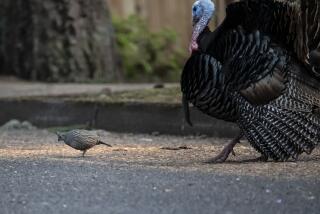Outdoors : TOMS TERRIFIC : Turkeys Learn to Be Wary in the Wild--and They Challenge a Hunter’s Nerve
- Share via
GRASS VALLEY, Calif. — Rhett Todd has been sitting absolutely still since before dawn, more than an hour ago. Insects are crawling around his neck, his legs have gone to sleep and he can feel the rock he is leaning against drawing the heat from his body. But if he scratches or so much as twitches, he may spoil everything.
Meanwhile, Mark Montgomery huddles under a madrone tree behind the rock, making female turkey sounds with various hand and mouth devices. Out in front, Todd, in full camouflage, waits patiently, his shotgun ready.
Yelp, yelp, Montgomery beckons.
Gobble, gobble, comes the reply--a few hundred yards away at first, then gradually closer, until two toms strut within range, their tails flared, about 40 yards away.
Yelp, yelp.
Gobble, gobble.
Montgomery hisses to Todd: “Take one . . . go ahead.”
Todd slowly--very slowly--swings his gun into line . . .
Todd, from Mussel Shoals near Santa Barbara, has hunted deer, waterfowl and upland game but will say later: “This is different from any kind of hunting I’ve ever done. This requires a lot more patience.”
With turkeys, it’s not hunting. It’s seduction. Especially in the spring, when toms are on the prowl for romance, and if a hunter or his guide--in this instance, Montgomery--can persuade one that love is around the corner, the game is on.
“The biggest thing is, don’t move,” Montgomery says. “Don’t even turn your head. You’ve got to be totally camouflaged. You figure, if you can see a guy sitting over there by that tree, so can the turkey.”
Turkeys have what Montgomery calls “telescopic vision.” They can spot a phony at 100 yards--more if they’re wary. In the still of an oak wood, they can hear a human voice for a mile.
“A lot of these younger toms out here were not shot at last April,” Montgomery says. “They made it through one fall season. So now that it’s mating season, they’re ready to go. If they hear a hen call, they’re not going to be too shy about it. They’re eager to run to about any call they hear.”
It helps to know the territory. Montgomery, who has been guiding hunters in the area for 17 years, scouted it the day before, when the season was about to open.
“I heard a guy calling last night that sounded terrible. Didn’t have any rhythm or tone or anything. But I heard two birds up in a tree gobbling.”
Generally, the spring hunt is better than the fall hunt because it’s mating season. But even then, there are no guarantees--even when the woods seem alive with turkeys.
At 5:15 a.m., when it’s barely light, the hunters hear gobbling as soon as they get out of the truck.
“From now on, all the talking should be in a whisper,” Montgomery whispers.
“Sometimes you’ll hear shooting this early in the morning. Some guys who aren’t real good callers will get ‘em when they’re still roosting . . . (sneak up and) shoot ‘em in the trees.”
Not sporting, Montgomery adds.
Sometimes, as happens this day, hens also will come to the calls, just looking for company. But in the spring, only the toms are fair game.
“There’s no doubt in the difference between a tom and a hen,” Montgomery says. “If you see a bright red throat and a blue head, you know it’s a tom. A hen, they have a little bit of pale pink on their throat and a dull gray head. And the tom is the only one that gobbles at you. The hen yelps--the sound I’ll make.
“I don’t like to make the tom noises. Some hunter out there that has never turkey-hunted before, if he hears a gobble in the bush, you never know what might happen.”
Montgomery further cautioned: “We haven’t had any rain for a while, so it’s real hard to move around quietly. These birds, when they’re walking around, they have two feet so they sound a lot like a human. If you hear a crunch-crunch coming toward you, it could be a turkey (or) it could be a hunter.
“If you do see a hunter sneaking in on you, you don’t want to wave at him or anything. You may want to clear your throat . . . make a human noise, rather than make movement that he might shoot at.”
Montgomery is a part-time surveyor for Nevada County. The county would like to hire him full time, but then he might not be able to spend April and November guiding turkey hunters.
He operates the Turkey Creek Guide Service out of nearby Penn Valley. Among the several guides working for him, Louis Tassone of Grass Valley won the California state turkey calling championship this year, and Jeff Brady won it in 1986 and ’87. Montgomery won it in ’85.
He whittled his first call out of cedar.
“I used to put a notch in it every time I killed a turkey,” he says, “until I got 50 turkeys.”
He says he has never been shut out on opening weekend of turkey season, and he will maintain that record this time--barely. Todd’s shot is the only opportunity he and his partner, Jack Kirby of Pasadena, will have in two days. That’s the way turkeys are.
“A lot of these big toms have a flock of hens with ‘em,” Montgomery says. “They’ll gobble to you when you call, but wherever the hens go, they’re going to go. Later in the season when the hens start to scatter, those big toms will get lonely and start looking for hens.
“The thing is, you call in five jakes--yearling toms--if you kill one of them, the other four are going to think, wow, we thought we were running into a hen and one of our buddies got shot.
“Then you call one of those four the next day and kill another one; the three that are left wise up even more. By the time you get down to the last two, they hear a hen call and go the other way.”
Kirby has bagged seven turkeys with a shotgun, but this time he wants a stiffer challenge: To get one with a bow and arrow--about 10 times more difficult, Montgomery says.
Montgomery did that last year.
“I called in a young tom,” he says. “He was about 17 yards out, looking around a tree. We looked at each other for about five seconds, then I made another series of calls, and he stepped out. I hit him dead center, and the arrow went clean through.
“By the time I got to him, he was up and running full speed. I ran him down for 200 yards, stumbling over rocks and logs.”
Todd is equipped with a Smith & Wesson 1500 12-gauge, using 1 1/4-ounce copper 6 shot with a tight choke for an 18-inch spread at 40 yards. He has never hunted turkeys.
Montgomery tells him: “You want to always aim for the head--except for you, Jack. You want to shoot for the biggest part.”
The difference is that shot won’t necessarily drop a turkey in the body--not to mention the problem of picking it out of your teeth at the dinner table.
“You can fill the body with a lot of pellets and not kill the turkey,” Montgomery says. “I’ve had guys call birds up 20 yards from them, aim right for the middle of the breast and shoot, and the bird will do two or three backflips and take off flying.
“The best way to shoot them is when they’re walking in to you. If they’re in full strut, usually I give a little warning . . . or the click of the safety or a guy shouldering his gun will bring them into an alert position where their neck is extended and their head is about 18 inches above their body.”
Montgomery asks Todd: “Are you right-handed? Try to have your left knee up, or maybe both knees up, and your gun lying on your left knee, and your left shoulder pointed slightly toward the direction from where you think the bird might come in. It’s a lot easier, if you’re right-handed, to shoot toward your left. If a bird comes in on your right, you can’t swing that direction very well.
“If he gobbles and you can’t quite see him, he may be looking at you. He’s got that telescope neck with two little beady eyes right on top. They can see a lot more than you think they can. A lot of times they’ll gobble here and sneak up over there to take a look.”
A hen is seen walking along the pond below, working its way up the slope. Then another hen, another, and soon two toms follow. As they ascend a small knoll, Todd selects the one in profile--and fires.
The bird, about 14 pounds, falls in its tracks. The other vanishes in an instant, wiser and warier. He may never trust his ears again.
Yelp, yelp.
Forget it.
More to Read
Go beyond the scoreboard
Get the latest on L.A.'s teams in the daily Sports Report newsletter.
You may occasionally receive promotional content from the Los Angeles Times.










